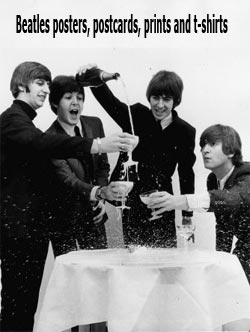 There's a new book out, about The Beatles and The Rolling Stones.
There's a new book out, about The Beatles and The Rolling Stones. Beatles vs. Stones (Simon & Schuster 320 pages, $26) by John McMillian is a book written by a historian and it does not take sides, McMillan assures us. "I have always been obsessed with both groups; the Beatles and the Rolling Stones are two of my favorite bands," McMillian says. "But I didn't want to allow myself to get drawn into a debate over which one is better, and have readers approach the book as if it was a treatise on behalf of one sensibility or the other."
McMillian reveals how music managers helped to construct the Beatles-Stones rivalry as they set out to engineer moneymaking empires. He explores how the Beatles were marketed as cute and amiable, when in fact they came from hardscrabble backgrounds in Liverpool. By contrast, the Stones were cast as an edgy, dangerous group, even though they mostly hailed from the London suburbs.
Sean O'Mahony, editor of both band's official fan magazines explains: "The Beatles were thugs who were put across as nice blokes, and the Rolling Stones were gentlemen who were made into thugs ..."
Although the Beatles always sold more records than the Stones, the Stones seemed to win greater credibility with the “right” types of fans: discerning bohemians, as opposed to hysterical teenyboppers. Later, the Beatles embraced Flower Power, while the Stones briefly aligned themselves with New Left militance. Ever since, writers and historians have associated the Beatles with the gauzy idealism of the “good” sixties and portrayed the Stones as representatives of the dangerous and nihilistic “bad” sixties. Beatles vs. Stones explodes that split.
In a lively narrative that whisks readers from Liverpool to London to New York City—and to various recording studios, nightclubs, concerts, courtrooms, and protest rallies in between—McMillian also delves into the personal relationships between the two groups. In one chapter we see Lennon and McCartney huddle up in a rehearsal space and show the Stones how to write their own material; in another we eavesdrop on Jagger and Richards as they watch the Beatles play Shea Stadium from the visitors’ dugout. McMillian also shows us how the two groups feuded about which act would headline a legendary Poll Winners’ concert and the pernicious effect that the American businessman Allen Klein had on both bands.
The author has examined both band's official fan magazines, both produced by Beat Publications, and it's editor "Johnny Dean", real name Sean O'Mahony.
Of course, the Beatles played a big part in the success of the Rolling Stones. First of all, the Rolling Stones benefited from the Beatles' Decca rejection.
On April 14th, 1963, the Beatles were at Teddington TV Studios, Middlesex, filming for ABC-TV's `Thank Your Lucky Stars'. After they drive to the Crawdaddy Club, Richmond, Surrey, London to see the Rolling Stones. After the show, there was a party at Mick Jagger, Brian Jones and Keith Richards' flat (102 Edith Grove, West Brompton, London). The Beatles attended, staying until 4am.
April 28, 1963, Andrew Loog Oldham, most recently working for Brian Epstein, sees The Rolling Stones at the band’s regular Sunday night session at the Crawdaddy Club, held at the Station Hotel in Richmond. Oldham had been looking for a project of his own, and eight days later, he and his partner, Eric Easton, sign a management contract with the band.
Even though the Liverpudlian Billy Fury was a successful recording artist in England just prior to the Beatles, the London based record companies were sceptical to upcoming bands and artists from the north. But once the Beatles had made it and become national stars, London's record companies started sending their talent scouts to Liverpool, signing up many of the bands from the local scene.
May 10th, 1963: Dick Rowe, head of Decca’s A&R, had been kicking himself ever since that fateful day in 1962 when he failed to sign The Beatles. On this day Rowe serves as a judge at the Lancashire and Cheshire Beat Group Contest held in Liverpool. Beatle George Harrison is also a judge, and admitting that turning down the Fab Four was his biggest regret in life, Rowe asked Harrison if he'd heard any good, unsigned band lately. The Beatle confided that he admired an unknown young rhythm and blues combo in Richmond, near London. Before the talent show was even over, Rowe raced to catch the next train to sign the Rolling Stones.
However, there are holes in this story, which this new book will shed some light on. According to the chronological history of the Rolling Stones, Dick Rowe had already signed them at the time of his chance encounter with Harrison on May 10th, as the band supposedly recorded their debut single on this date.
- May 5, 1963: Dick Rowe of Decca Records witnesses the Rolling Stones in concert.
- May 6, 1963: The Rolling Stones sign a management contract with Andrew Oldham and Eric Easton.
- May 8-9, 1963: Brian Jones signs the Rolling Stones to a 3-year recording deal with Decca Records.
- May 10, 1963: The Rolling Stones record the two sides of their first single at Olympic Sound Studios in London.
In Beatles vs Stones, McMillian has Rowe attending a Stones gig on May 12th and the Decca signing at May 14th. The author also disputes the story of Rowe leaving Liverpool abruptly.
On September 10th, John Lennon and Paul McCartney go by taxi from the Savoy Hotel to their apartment (57 Green Street). While riding down Jermyn Street, they see Andrew Oldham, who invites them to see the Rolling Stones rehearse at the Ken Colyer Club. The Stones are having trouble coming up with a second single, Oldham confides. Lennon and McCartney offer to help, going with Oldham to the Stones’ rehearsal studio and playing the unfinished “I Wanna Be Your Man.” The Stones liked it, and to their astonishment, Lennon and McCartney finished it off right there. “It was a throwaway,” Lennon admitted. “We weren’t going to give them anything great, right?” This original by the hottest songwriting team of the year gives the Stones the band’s first Top 20 hit in the U.K.
Getting a good record contract in USA proved to have the same obstacle for The Beatles as they had faced when trying to get signed by record companies in London. Even though some British artists had enjoyed brief placings in the US charts, the American record companies were sceptics about bands and artists from Great Britain. But again, once the Beatles' formidable breakthrough in the USA had happened, they paved the way for a lot of British bands, and the Rolling Stones followed in the Beatles' footsteps there.
Recently, on the Howard Stern Show, Paul McCartney was asked if he thought the Rolling Stones copied the Beatles, to which he replied: "That is the truth. Look at the history: The Beatles go to America, a year later they come too,". "We wrote their first single (sic), I Wanna Be Your Man. We go psychedelic, they go psychedelic. We dress as wizards, they dress as wizards...". Paul also said he loves the Stones and that they have been friends since the 60s, and he also thought that his own constant touring was a contributing factor in getting the Rolling Stones back on the road again.
I was present at a showing of the 1964 NME Poll Winners' concert at the British Film Institute way back in the eighties. Every scrap of film had been found and pieced together for this showing and it was fun to watch. Most of the acts were new and they appeared very nervous to be performing to such a large audience. All, except for the Beatles and the Rolling Stones, both these bands had an on stage presence the other bands lacked.
The timing of this book couldn't have been better: November 11th, both bands are releasing new albums: The Beatles' On Air - Live at the BBC Volume 2 on CD and vinyl, and Sweet Summer Sun - Hyde Park Live on DVD, Blu-ray, vinyl and CD. Back when the two bands were competing against each other, the Rolling Stones made sure never to release a new album or single around the same date as the Beatles.
Also, on November 1st, a new concert documentary is released theatrically, featuring both the Rolling Stones and Paul McCartney:
On December 12, 2012, some of entertainment's most iconic names came together at Madison Square Garden for a historic concert to benefit the victims of Hurricane Sandy. 12-12-12 captures the unprecedented gathering of talent who turned up on stage and behind the scenes to raise over $50 million in one night for the Robin Hood Hurricane Sandy Relief Fund to support organizations helping victims in New York, New Jersey and Connecticut.
The evening's Emmy Award-nominated telecast included performances by some of the music industry's legendary acts: Bruce Springsteen and the E Street Band, Billy Joel, Alicia Keys, Paul McCartney, Dave Grohl, Roger Waters, Eddie Vedder, Chris Martin, Michael Stipe, Adam Sandler, Eric Clapton, Jon Bon Jovi, The Rolling Stones, The Who and Kanye West.

































No comments:
Post a Comment